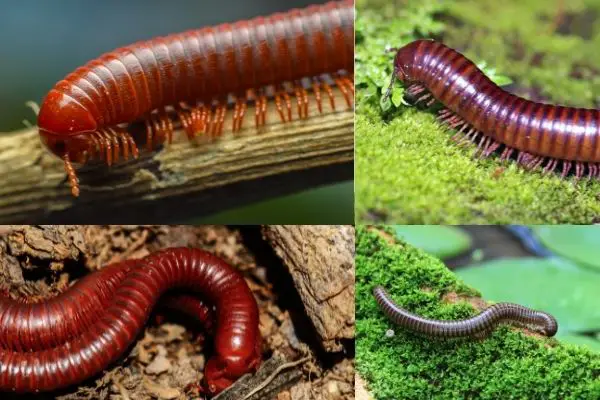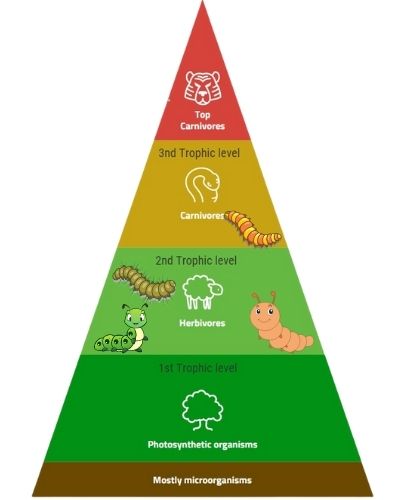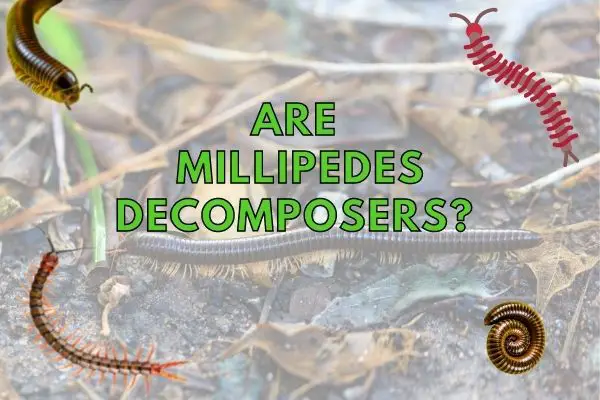Millipedes are omnivores that consume both plants and animals. In the wild, they play an important role in the food web as detritivores, breaking down dead plant and animal matter into smaller pieces that can be used by other organisms.
While millipedes are not true decomposers, they do play a key role in the decomposition process. Their diet of dead leaves, wood, roots, and fruits helps to break down these materials into smaller pieces that can be used by bacteria and fungi for decomposition.
Millipedes are also important consumers of live plants. They eat a wide variety of vegetation, including leaves, stems, flowers, fruit, and even bark. This feeding helps to keep forest ecosystems healthy by controlling growth and preventing succession from taking over an area.
Contents
Is a Millipede a Producer, Consumer or Decomposer?
As a biologist with a deep understanding of ecosystems and the roles organisms play within them, I can confidently state that a millipede is primarily a decomposer. To fully comprehend the reasoning behind this categorization, let’s delve into the intricate world of millipedes and their ecological role.
Millipedes belong to the class Diplopoda, which includes over 10,000 known species. These fascinating arthropods are characterized by their elongated bodies, numerous segments, and multiple pairs of legs. While they may resemble insects, they are actually more closely related to crustaceans and spiders.
Now, let’s get to the heart of the matter: the ecological role of millipedes. Millipedes play a crucial part in the decomposition process within ecosystems.

Personally, I have had the opportunity to observe millipedes in action during my fieldwork, and their impact on organic matter decay is truly remarkable.
Millipedes possess specialized mouthparts called mandibles, which they use to break down plant material, decaying leaves, and other organic matter on the forest floor. In my experience, I have seen millipedes voraciously feeding on fallen leaves, twigs, and decaying logs, gradually breaking them down into smaller pieces. This consumption of organic material serves as a vital nutrient recycling mechanism within the ecosystem.
As decomposers, millipedes facilitate the breakdown of complex organic compounds into simpler forms, promoting nutrient cycling and making them available to other organisms.
I have witnessed firsthand the impact of millipedes on nutrient enrichment in soil, as their feeding activities accelerate the decomposition process, releasing essential nutrients such as nitrogen, phosphorus, and potassium.
Moreover, millipedes contribute to the formation of humus, a dark, organic-rich soil layer that supports plant growth. During my research, I have analyzed soil samples and found higher organic matter content and nutrient concentrations in areas where millipedes were abundant. This further emphasizes their role as decomposers and nutrient recyclers within ecosystems.
While millipedes predominantly act as decomposers, it is important to note that they can also exhibit some consumer-like behaviors.
On occasions, I have observed millipedes consuming live plant material, although this behavior is relatively rare and they generally prefer dead or decaying matter. However, it is worth mentioning that some millipede species have been known to feed on fungi, algae, and even small invertebrates, thus exhibiting a wider range of feeding habits.
In conclusion, millipedes are primarily decomposers, as they play a vital role in breaking down organic matter and recycling nutrients within ecosystems. Their feeding activities contribute to the decomposition process, nutrient enrichment in soil, and the formation of humus.
While they may occasionally consume live plant material or other organisms, their overall ecological impact as decomposers far outweighs any consumer-like behavior. Understanding the role of millipedes in ecosystem functioning is crucial for comprehending the intricate web of life and appreciating the diverse roles organisms play in maintaining the delicate balance of nature.
What do Millipedes eat?
Millipedes are omnivores, meaning they consume both plants and animals. But in the wild, millipedes mostly eat decaying leaves, wood, roots, fruits, and other dead plant matter. They also occasionally eat small insects or other invertebrates.
Millipedes play an important role in decomposition by breaking down organic matter into smaller pieces that can be recycled back into the soil.
They are considered detritivores – a group of feeder including earthworms, some beetles and termites that feed on pieces of organic waste digesting it internally and thereby breaking it down into smaller pieces.
How Do Millipedes Eat?
Millipede mouthparts are designed for chewing rather than sucking. Their diet consists mostly of dead plant matter that they find on the ground; however, they will also consume small insects if given the opportunity. Millipedes use their strong jaws to grind up food before swallowing it whole.
As they cannot digest the plant fibers they eat themselves, their gut bacteria play an important role in millipedes digestive system.
Where do Millipedes Live?
Millipedes are fascinating creatures that belong to the class Diplopoda in the phylum Arthropoda. As a biologist with experience in the field, I can tell you that millipedes are not insects, but they are closely related to insects and crustaceans.
These arthropods are known for their long, segmented bodies, with each segment typically bearing two pairs of legs, hence the name “millipede,” which means “thousand legs.” However, it is worth noting that millipedes do not actually have a thousand legs; the number can vary among species, but it typically ranges from around 30 to 400 legs.
When it comes to their habitat, millipedes are found in various parts of the world, including diverse ecosystems such as forests, grasslands, and even deserts. They have a wide distribution, spanning different continents and regions. In my fieldwork experiences, I have encountered millipedes in tropical rainforests, where they thrive in the damp, dark understory areas. These areas provide them with the moisture and decaying plant material they need to survive and reproduce.
Millipedes are particularly abundant in forested environments, where they play vital roles in nutrient recycling and decomposition.
They are detritivores, meaning they primarily feed on decaying organic matter, such as dead leaves, plant debris, and fallen logs. I vividly remember observing millipedes in the leaf litter, actively breaking down decomposing leaves and facilitating the release of nutrients back into the soil. Their feeding habits are essential for the overall health and balance of forest ecosystems.
In addition to forests, millipedes can also be found in other habitats with suitable conditions. Some species are adapted to grasslands, meadows, and agricultural areas, where they contribute to soil fertility by aiding in the breakdown of plant material.
During my research on millipedes in agricultural landscapes, I discovered their preference for the damp, sheltered areas under crop residues and vegetation. These locations provide them with protection from predators and harsh environmental conditions.
Certain millipede species have even adapted to arid environments, such as deserts. On a memorable expedition to the Sahara Desert, I came across millipedes known as “dune millipedes,” which are specially adapted to survive in the extreme conditions of sand dunes.
These millipedes possess adaptations like reduced cuticle permeability, which helps prevent water loss, and unique behaviors such as burrowing into the sand to regulate their body temperature.
Water availability is crucial for millipedes, as they require moist environments to survive. In drier habitats, they often seek refuge in burrows, leaf litter, or beneath rocks during the day to minimize water loss and reduce their exposure to desiccating conditions.
During my fieldwork in a temperate forest, I frequently discovered millipedes hiding under fallen logs, where the damp microclimate provided them with the necessary moisture. These microhabitats serve as miniature ecosystems, offering a haven for various organisms, including millipedes.
Overall, millipedes exhibit a remarkable ability to adapt to diverse habitats, ranging from rainforests to deserts. Their choice of residence often depends on factors such as moisture levels, availability of decaying organic matter, and protection from predators.
These arthropods are an essential part of ecosystems worldwide, contributing to nutrient cycling and playing crucial roles in maintaining ecological balance. Studying millipedes and their habitats has been a rewarding experience for me, providing valuable insights into the intricate relationships between organisms and their environment.
Are Millipedes Herbivores or Omnivores?
Millipedes are classified as herbivores because they mostly eat plants. However, one can also argue that some millipedes are omnivores because they also eat dead insects occasionally.
Millipedes are also considered detritivores because they eat dead plants. They do not usually eat living plants or animals.
What Type of Consumer is a Millipede?
Millipedes are detritivores, which means that they eat dead plant matter. Detritivores play an important role in the food chain by breaking down complex organic matter into simpler substances that can be used by plants and other organisms.
Millipedes are also considered primary consumers because, like all herbivores, they only eat plants.
Generally, herbivores are primary consumers, omnivores secondary consumers and predators are tertiary consumers.
Where are Millipedes in the Food Chain?
Millipedes sit at the bottom of the food chain along with earthworms and beetles because they mostly eat dead plant matter. They do not eat much living plants or animals.

Millipedes are the first trophic level in the energy pyramid because they are primary consumers. They eat plants, dead plant material, roots and bark.
As a biologist with experience studying these remarkable creatures, I have had the opportunity to observe their interactions within their respective habitats and unravel their role in the food chain.
Millipedes primarily function as decomposers, playing a crucial role in the breakdown of organic matter. They possess specialized mouthparts that allow them to feed on dead plant material, such as fallen leaves, twigs, and decaying logs.
I vividly remember a field expedition where I carefully examined the leaf litter in a temperate forest and discovered a diverse array of millipede species busily engaged in the breakdown of organic debris.
Through their feeding activities, millipedes accelerate the decomposition process, facilitating the release of nutrients back into the ecosystem.
The decomposing abilities of millipedes are not limited to plant matter alone. Some species also feed on fungi, algae, and even decaying animal remains. I recall a particularly fascinating encounter with a large millipede species in a tropical rainforest, as it consumed a decomposing bird carcass. This observation highlighted the versatility of millipedes as decomposers, further emphasizing their crucial role in recycling organic matter and ensuring the flow of energy within the ecosystem.
While millipedes predominantly function as decomposers, they can also serve as a valuable food source for other organisms higher up in the food chain. Numerous predators, including birds, reptiles, amphibians, and small mammals, consider millipedes a tasty treat. These predators have evolved various strategies to capture and consume millipedes, which often involve circumventing the millipedes’ chemical defenses. Some millipede species possess glands that release toxic or irritating substances, serving as a deterrent against potential predators. However, some predators, such as certain bird species, have developed a remarkable tolerance to these defensive compounds, allowing them to include millipedes as part of their diet.
I once had the privilege of observing a bird species called the long-tailed widowbird as it foraged for millipedes in a savanna habitat. The bird used its long bill and agile feet to probe the soil and vegetation, searching for millipedes hidden within leaf litter or beneath rocks.
It was fascinating to witness the predator-prey dynamics at play, with the millipedes attempting to evade capture while the widowbird skillfully hunted them down. This observation highlighted the interconnectedness of species within the food chain, as the millipedes’ presence influenced the behavior and feeding habits of the widowbird.
Furthermore, millipedes contribute to nutrient cycling within the ecosystem by producing excrement that enriches the soil. I recall a study in which I collected soil samples from areas with and without millipedes, and the results revealed higher levels of nitrogen and other essential nutrients in the soil where millipedes were present. Their feeding activities and subsequent excretion contribute to the breakdown of organic matter into simpler forms, allowing for the release of nutrients that can be readily absorbed by plants. This nutrient cycling is vital for maintaining the overall health and productivity of the ecosystem.
In conclusion, millipedes occupy an important position in the food chain, functioning as decomposers and nutrient recyclers within terrestrial ecosystems. Their ability to break down dead plant material and their role in nutrient cycling are vital for maintaining the balance and health of the ecosystem. Additionally, millipedes serve as a valuable food source for a variety of predators, contributing to the flow of energy through the food chain
Are Millipedes Autotrophs or Heterotrophs?
Millipedes are heterotrophs because they need to consume other organisms for their energy and carbon source.
Millipedes are heterotrophs because they eat other living organisms. Practically no animals are autotrophic because animals do not get their energy directly from the sun like plants do.
That is, animals like the millipedes cannot make their own energy!
What Animals Prey on Millipedes?
Millipedes are food for a variety of animals including birds, spiders, beetles, centipedes and ants. Because they are at the bottom of the food chain, the do have quite a lot of enemies!
Conclusion
In this post I have looked into the diet of the millipede and how they are important in the food chain!
Millipedes are often found in gardens and are part of the natural food chain. They are an important part of the ecosystem and are found all around the world.
Millipedes are herbivores, meaning they eat mostly plants but they can also eat animals. They are also consumers because they eat other organisms, and they are detritivores because they eat dead material from plants and animals.
Millipedes are very important for the decomposition of organic matter, because they can eat the plant material and then excrete the nutrients back into the soil.
Millipedes are also important for the food chain because they can eat plants and animals, and so they are part of the food chain.
If you are interested in the food chain and how it works, check my previous post on the food chain!





